Overview
The article examines the various applications of 10 ml pipette tips within pharmaceutical laboratories, highlighting their essential function in ensuring precision and accuracy in liquid handling across diverse scientific disciplines. This discussion is reinforced by a thorough analysis of how these tools improve experimental reliability, reduce contamination risks, and enhance the overall efficiency and effectiveness of laboratory workflows. By focusing on these critical aspects, the article underscores the vital role that high-quality scientific instruments play in advancing laboratory practices.
Introduction
In the intricate world of pharmaceutical research, the precision of liquid handling tools is paramount; even the slightest miscalculation can lead to significant consequences. The 10 ml pipette tip stands out as a vital instrument, providing researchers with unparalleled accuracy and reliability in their experiments. As the demand for high-quality liquid handling solutions continues to rise, laboratories must consider how to leverage the full potential of these essential tools. This enhancement not only accelerates drug development but also ensures adherence to stringent quality standards. How can laboratories rise to this challenge?
JM Science 10 ml Pipette Tips: Precision for Accurate Liquid Handling
JM Science's 10 ml pipette tip dispensing points exemplify outstanding accuracy in fluid management, which is a critical component in pharmaceutical research. Their design ensures a snug fit with the 10 ml pipette tip, significantly minimizing the risk of air bubbles and ensuring precise volume delivery. In pharmaceutical laboratories, where even minor discrepancies can lead to substantial variations in results, this precision is paramount. The recommendations aim to reduce fluid retention, enabling optimal fluid dispensation with each application, thus enhancing experimental precision.
Constructed from high-quality materials that resist chemical interactions, these tips preserve the integrity of samples throughout the handling process. This level of accuracy is essential for applications such as high-performance fluid chromatography (HPLC) and other analytical methods prevalent in pharmaceutical research. With the market for manual fluid handling devices projected to reach USD 7.6 billion by 2032, the emphasis on precise volume delivery in research environments becomes increasingly significant. Ongoing advancements in pipette design, including ergonomic features and digital displays, further underscore the importance of precision in pharmaceutical labs, ensuring that researchers can depend on their tools for consistent and reliable results. As noted by Shruti Bhat, the rising demand for in laboratory settings is a key driver of this market expansion.
Moreover, the manual fluid handling devices market is anticipated to grow at a CAGR of 4.9% from 2023 to 2032, highlighting the escalating importance of precision in fluid handling as the market evolves. However, it is crucial to recognize the potential threat posed by the increasing adoption of automated liquid handling systems, which offer higher throughput and reduced human error, making them appealing alternatives to manual devices.
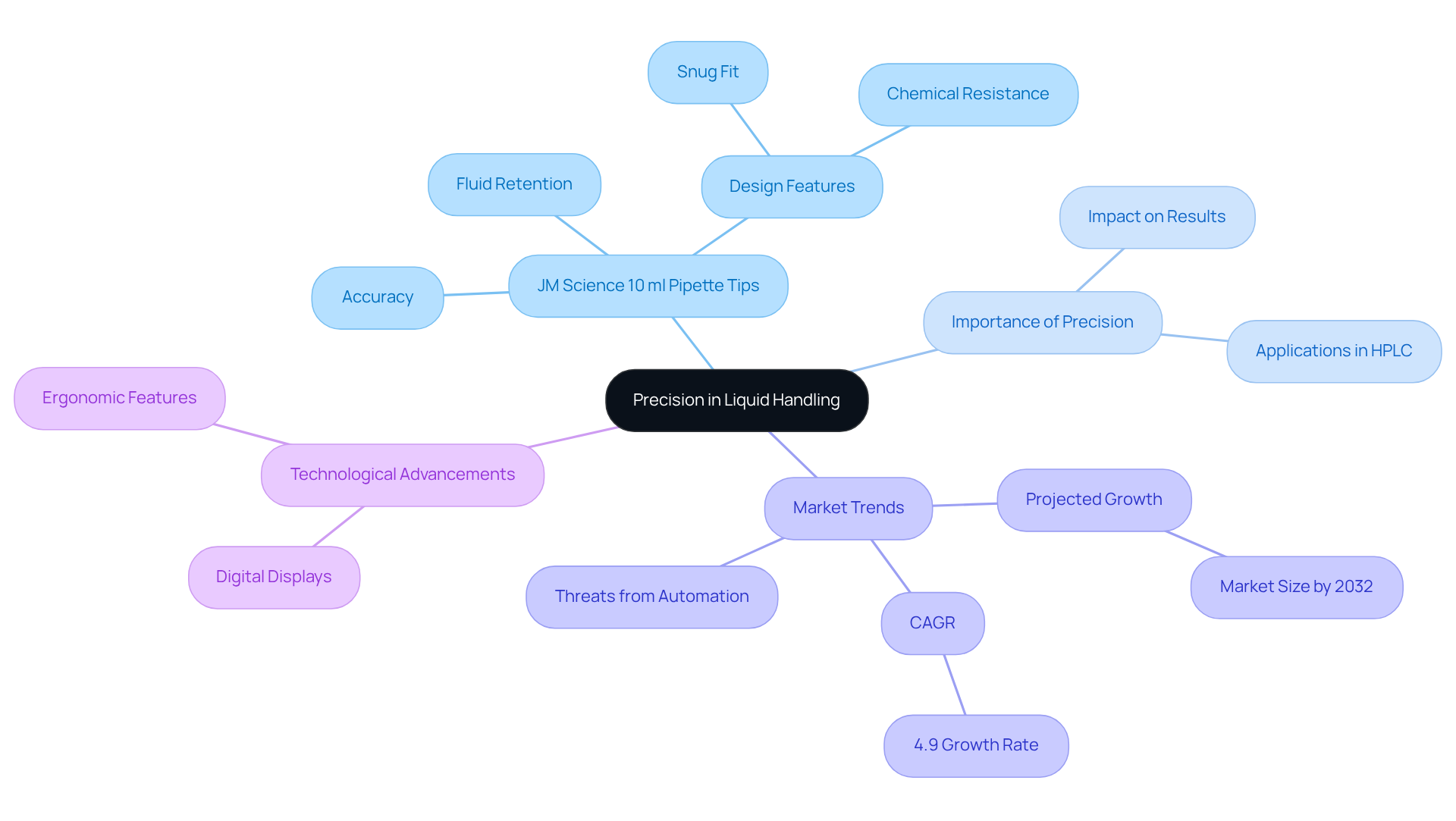
Pharmaceutical Applications: Enhancing Drug Development with 10 ml Pipette Tips
In pharmaceutical laboratories, 10 ml dispensing ends are essential at various stages of drug development, particularly in formulation and quality assurance. These tools excel in preparing solutions, diluting samples, and transferring reagents with remarkable accuracy. Their ability to efficiently handle larger volumes enables researchers to optimize workflows, significantly reducing the time spent on repetitive tasks.
The implementation of high-quality laboratory dispensers is vital for minimizing contamination risks, a critical factor in preserving the integrity of drug formulations. By ensuring that each transfer is precise and free from contaminants, pharmaceutical labs enhance the reliability of their experimental outcomes. This emphasis on accuracy not only streamlines the drug development process but also fosters the creation of more effective therapeutic solutions. As noted, "Reducing contamination in drug formulation is crucial for attaining precise and consistent outcomes, and the appropriate dispensing tools are essential in this endeavor." The impact of these tools on pharmaceutical workflows is profound, as they play a pivotal role in the success of drug development initiatives.
Furthermore, the market for liquid handling instruments is projected to grow from $2.28 billion in 2024 to $2.46 billion in 2025, reflecting a CAGR of 7.8%. This growth underscores the increasing demand for reliable liquid handling devices in the pharmaceutical industry.
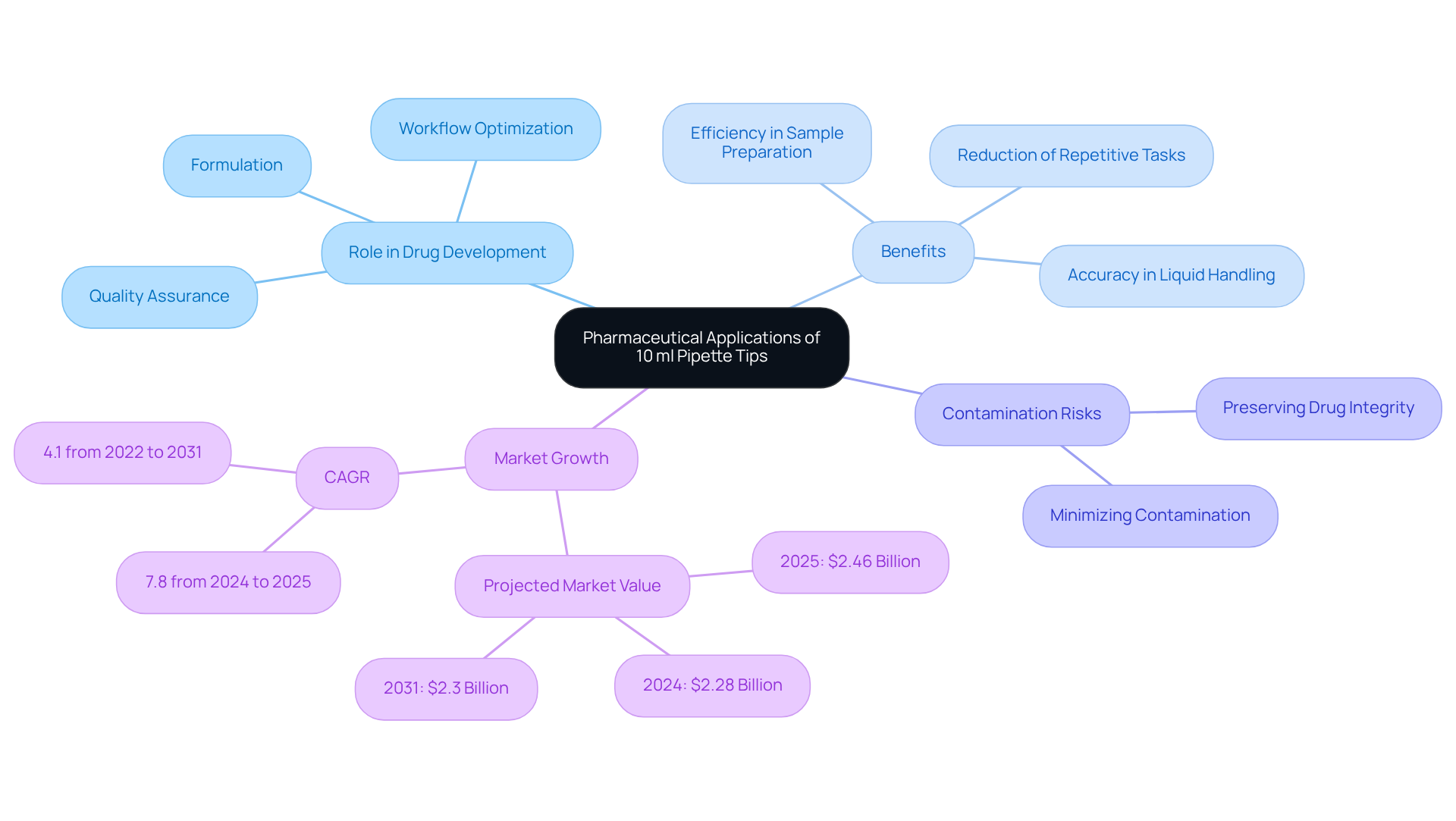
Medical Diagnostics: Utilizing 10 ml Pipette Tips for Accurate Sample Analysis
In medical diagnostics, the accuracy of sample analysis profoundly influences patient outcomes. The utilization of the 10 ml pipette tip is essential for the precise transfer of blood, serum, and other biological samples. Their innovative design facilitates the , ensuring that the correct volume is consistently dispensed.
Employing high-grade laboratory tools significantly reduces the risk of cross-contamination—an aspect that is particularly crucial in clinical environments where samples must remain uncontaminated to guarantee accurate test results. Furthermore, the ergonomic design of these tools enhances usability, thereby minimizing the likelihood of user errors during sample preparation and analysis.
In conclusion, the integration of quality laboratory instruments not only safeguards the integrity of samples but also promotes a higher standard of diagnostic accuracy. Investing in such tools is a decisive step toward ensuring optimal patient care.
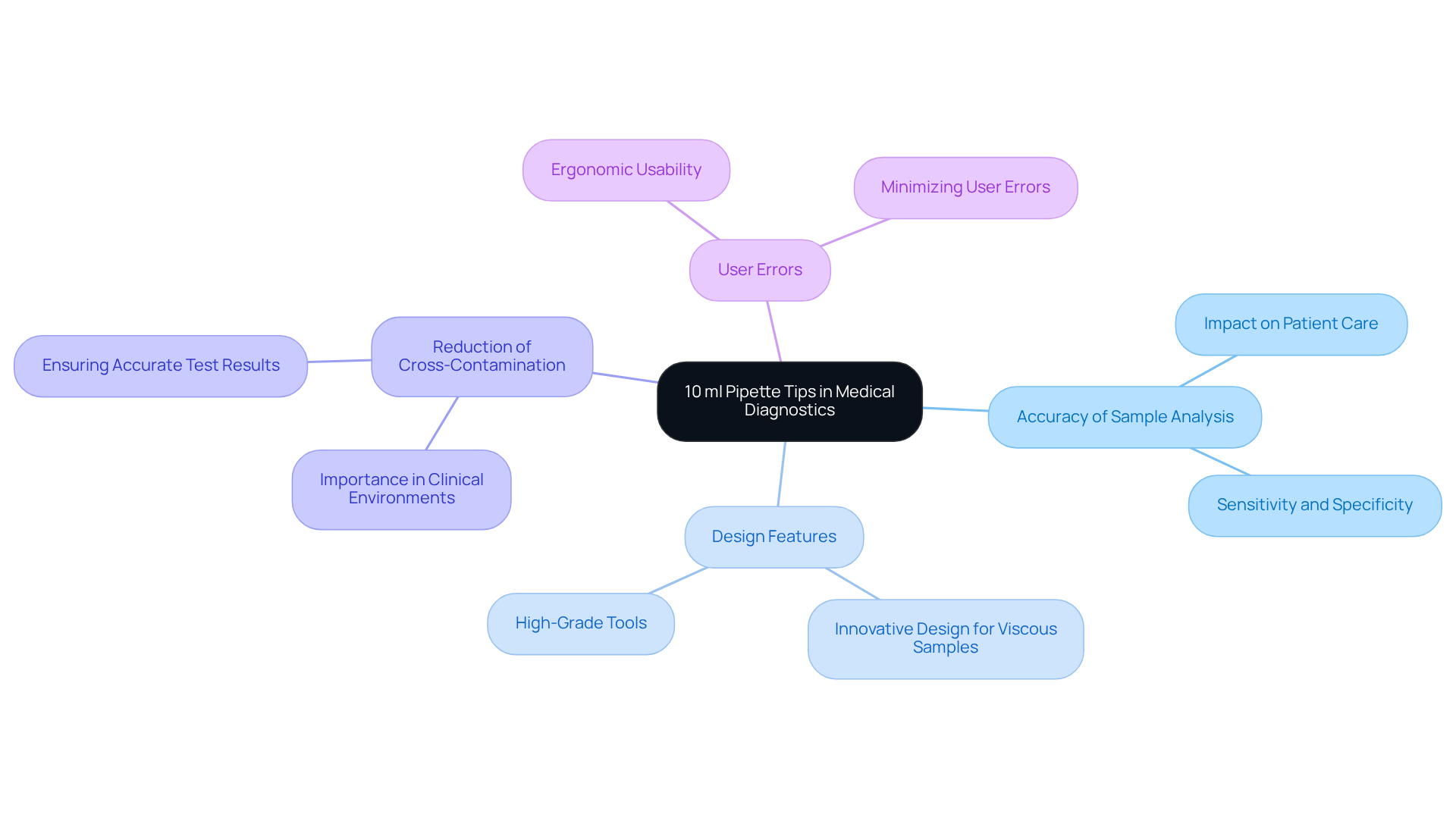
Environmental Testing: Leveraging 10 ml Pipette Tips for Sample Collection and Analysis
Environmental testing laboratories rely on 10 ml pipette tips as sampling tools for the precise collection and examination of samples from diverse sources, including water, soil, and air. The accuracy provided by these tools is crucial for effectively assessing contaminants, which is vital for adhering to environmental regulations. High-precision laboratories may necessitate monthly calibrations to uphold equipment accuracy, highlighting the significance of regular maintenance in achieving dependable results.
Handling larger volumes with precision allows researchers to perform more comprehensive testing, producing substantial data that can influence environmental policies and practices. Additionally, employing high-quality 10 ml pipette tips significantly reduces the risk of sample contamination, ensuring that the results accurately reflect the environmental conditions being evaluated. It is also essential to recognize that dripping may occur when using transfer tools, particularly with volatile substances, potentially compromising sample integrity.
In the field of environmental sample analysis, precision is of utmost importance. As noted by industry specialists, "A well-maintained instrument provides confidence that you are working with a precise tool, but the accuracy of each dispense is determined by correct use of that tool, and the experience of the operator." This statement emphasizes the necessity of , the careful selection of appropriate tools, and the consideration of environmental conditions to achieve reliable results.
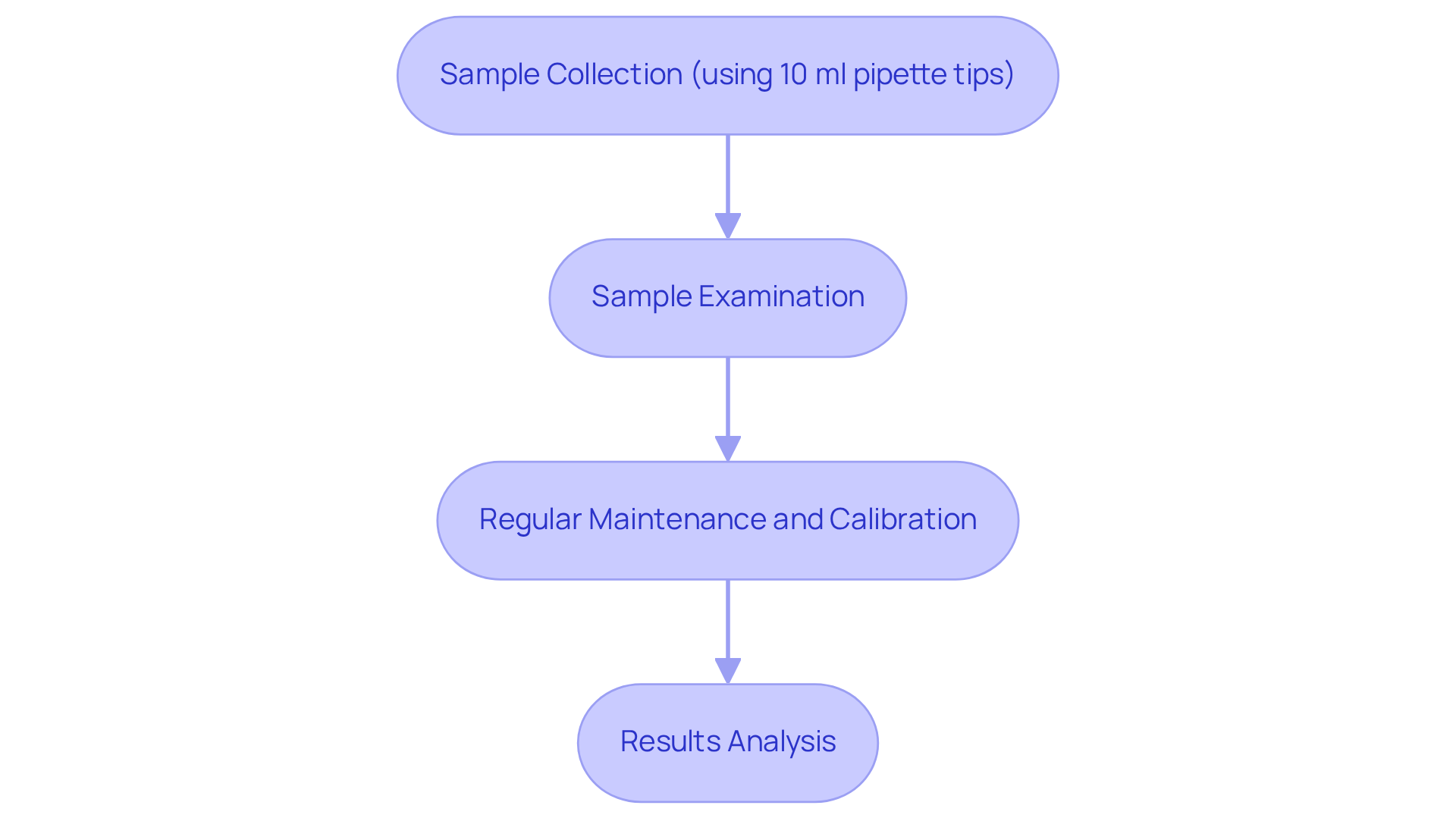
Educational Laboratories: Implementing 10 ml Pipette Tips for Hands-On Learning
In educational settings, 10 ml pipette tips are indispensable for teaching essential liquid handling techniques to students. Their application not only fosters an understanding of precision and accuracy in scientific experiments but also equips students with vital skills for their future careers in research and industry. The Royal Society of Chemistry emphasizes the necessity of 300 hours of practical work for a bachelor's degree in chemistry, underscoring the critical role of hands-on experience in education.
The ergonomic design of these 10 ml pipette tips significantly reduces strain during prolonged use, which is a crucial feature in educational environments where students may partake in extended laboratory sessions. By prioritizing comfort and usability, these instruments enhance the overall learning experience, allowing students to focus on refining their techniques and mastering the art of liquid handling. As educator Katherine Johnson aptly states, "Do the research. Ask questions. Find someone doing what you are interested in! Be curious!" This perspective highlights the importance of in cultivating curiosity and skill development.
Moreover, statistical analysis reveals that 95% of educators find in-person labs to be more beneficial for student engagement and comprehension, thereby reinforcing the effectiveness of practical learning environments, particularly when ergonomic tools are utilized.
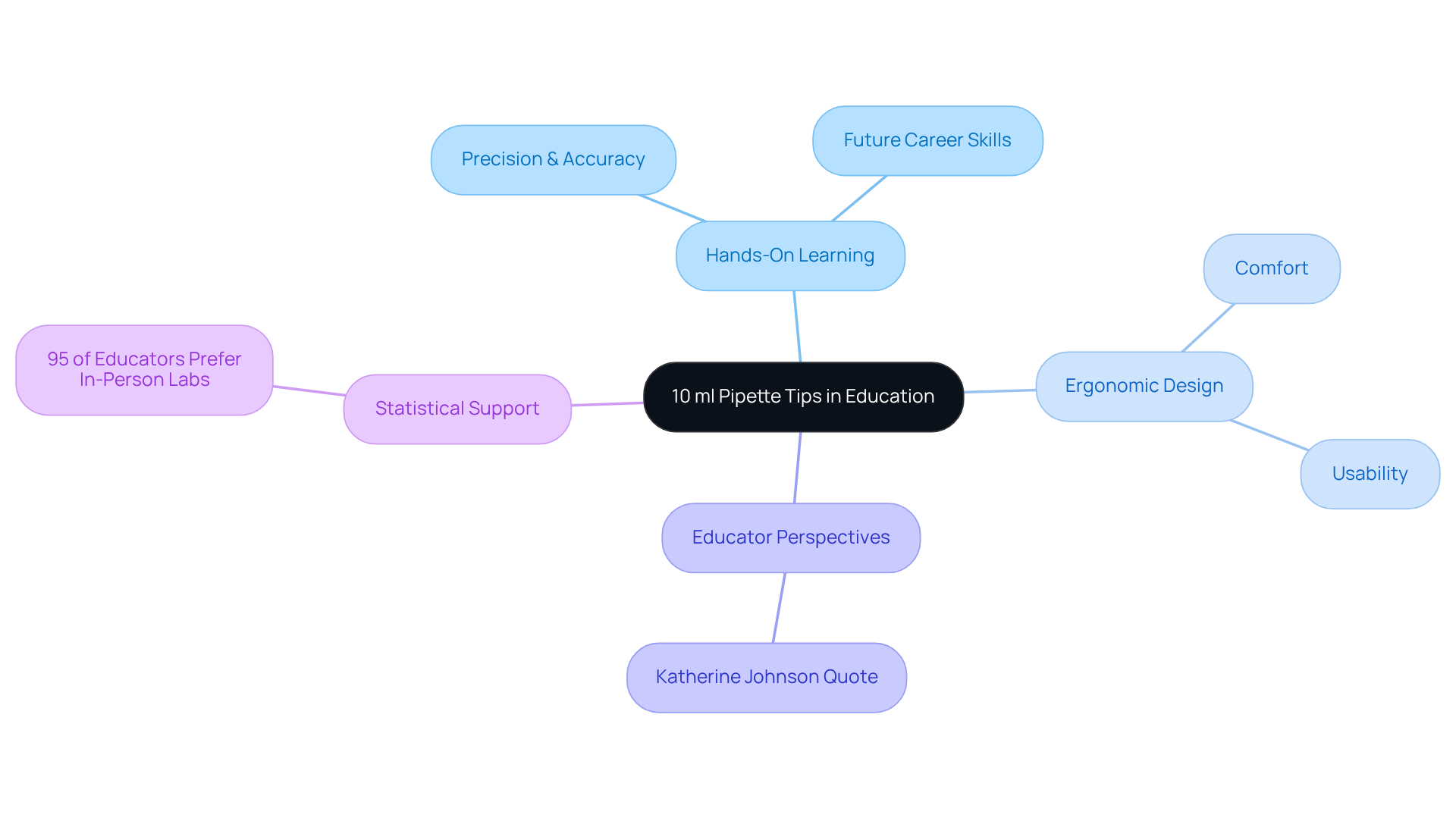
Quality Control: Ensuring Consistency with 10 ml Pipette Tips in Manufacturing
In manufacturing settings, particularly within the pharmaceuticals and food production sectors, the use of a 10 ml pipette tip is indispensable for quality control procedures. These tools are vital for ensuring that samples are collected and analyzed with precision, which is essential for and safety. The accuracy of these dispensing instruments, such as the 10 ml pipette tip, allows for precise measurements of components and additives, ensuring that formulations comply with stringent regulatory standards. By utilizing high-quality dispensing tools, manufacturers can significantly reduce variability in production processes, leading to more reliable products and a decrease in recalls related to quality issues.
Furthermore, the implementation of Statistical Process Control (SPC) techniques, such as control charts, enhances this consistency by monitoring variations in measurements, thereby protecting product safety and efficacy. For example, the use of control charts for tablet weight has demonstrated a reduction in defect rates by 23%, illustrating the effectiveness of statistical methods in safeguarding product quality. Investing in reliable dispensing tools not only helps manufacturers maintain the integrity of their products but also ultimately enhances patient safety and satisfaction.
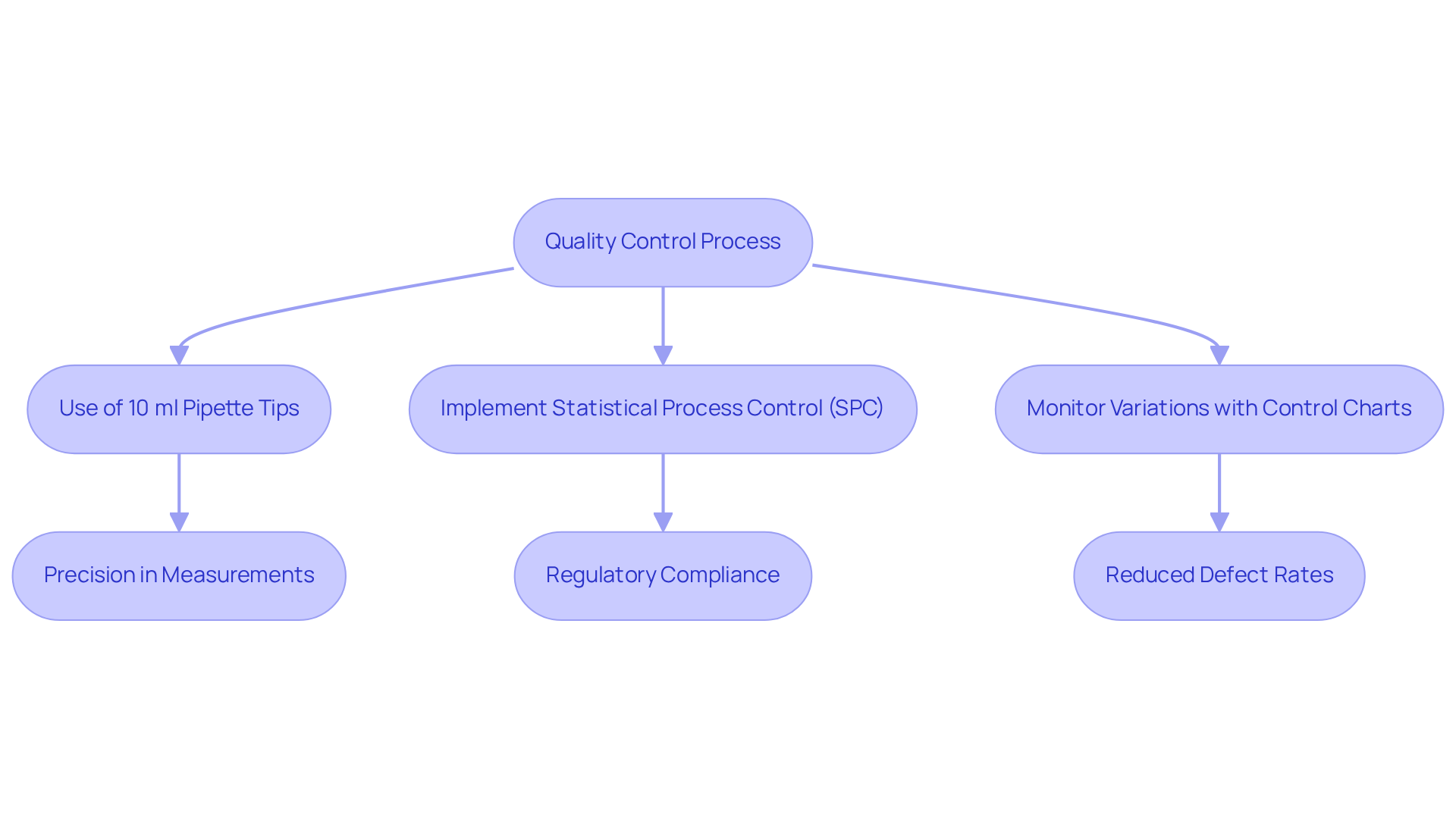
Research Laboratories: Employing 10 ml Pipette Tips for Experimental Precision
In research laboratories, the use of 10 ml pipette tips is indispensable for achieving experimental precision. These instruments empower researchers to accurately distribute reagents and samples with a 10 ml pipette tip, which is a critical factor for the reproducibility of experiments. As Sarah Lee asserts, "Precision and accuracy are crucial to any lab experiment. Therefore, it is paramount that each material or chemical in the experiment is measured as carefully and specifically as possible to get the best results." The ability to manage larger quantities effectively also facilitates complex experimental designs that require precise fluid transfers with a 10 ml pipette tip.
Furthermore, the high-quality materials employed in these transfer devices guarantee compatibility with a broad spectrum of chemicals, thereby minimizing the risk of chemical interactions that could jeopardize experimental integrity. This reliability is vital for researchers who rely on accurate data to substantiate their findings. A case study titled 'The Role of Liquid Handling Accessories in Achieving Accurate and Reproducible Results' highlights that high-quality liquid handling tools significantly improve experimental outcomes by ensuring consistent liquid retention and precise volume transfer. This underscores the in scientific inquiry.
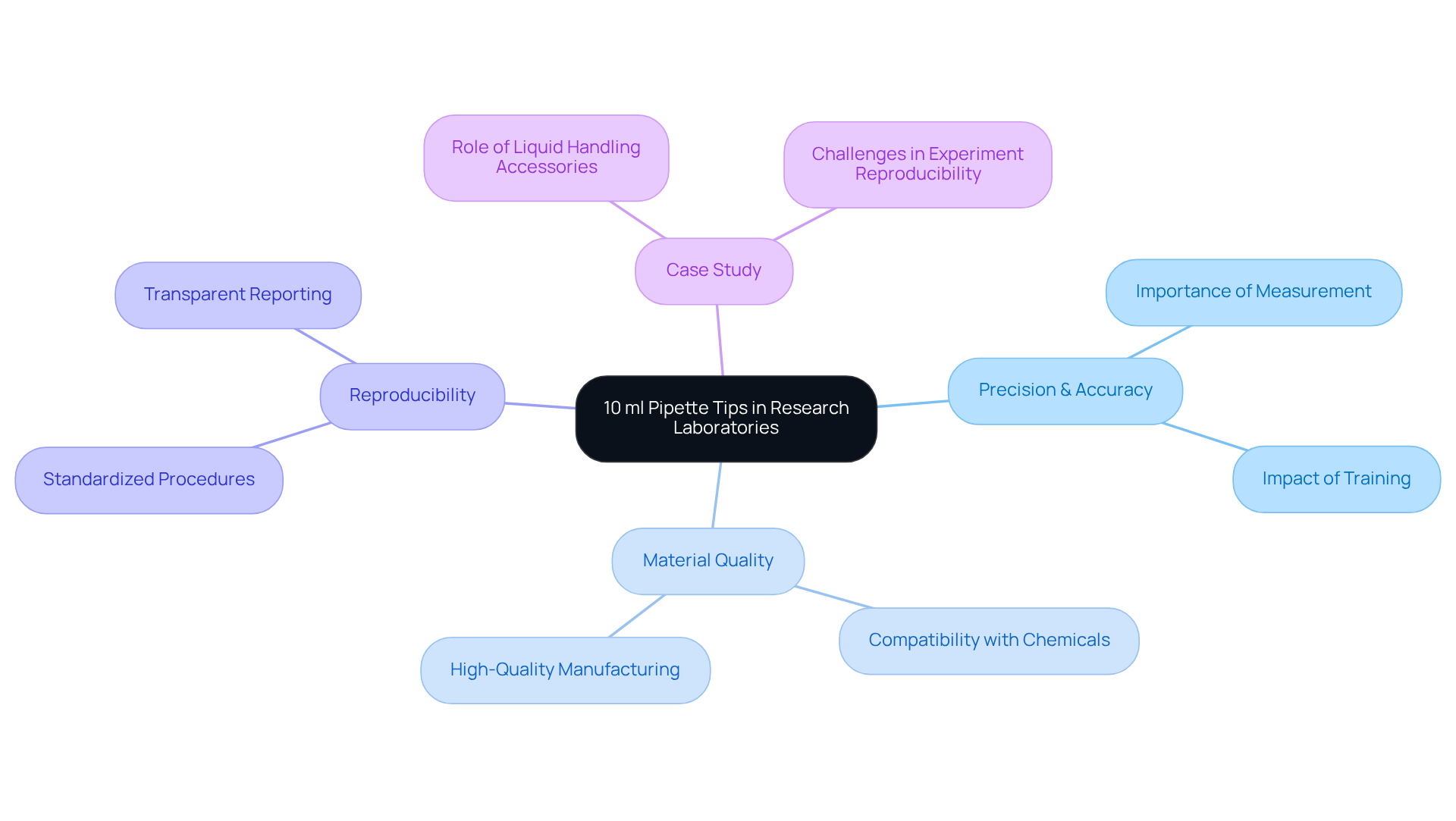
Biotechnology: Utilizing 10 ml Pipette Tips in Innovative Research
In biotechnology, the use of 10 ml pipette tips is essential across various applications, including cell culture, genetic engineering, and protein analysis. Their accuracy is vital for precisely measuring and transferring biological specimens and reagents, which is necessary for achieving successful experimental outcomes. Moreover, the ability to handle larger volumes with ease allows researchers to conduct experiments that require significant liquid quantities, such as large-scale cell cultures, thereby enhancing productivity and efficiency in laboratory workflows.
Furthermore, utilizing high-quality dispensing tools significantly reduces the risk of contamination, a critical factor in preserving the integrity of biological samples. Contamination can compromise experimental results, leading to unreliable data and wasted resources. Thus, employing disposable instruments designed to is crucial for ensuring the precision and trustworthiness of experiments in biotechnology. This emphasis on contamination prevention is echoed in industry insights, underscoring the necessity of stringent quality standards in laboratory practices. By ensuring that sample collection tools meet these standards, researchers can conduct their work confidently, assured that their results will be valid and reproducible.
As stated by Monali Tayade, a research analyst, "The quality of liquid handling devices is crucial for preserving the integrity of experiments, particularly in the swiftly expanding pharmaceutical and biotechnology industries, which represented more than 32.3% of overall revenue in 2021." Furthermore, the global market for laboratory dispensers is anticipated to expand at a CAGR of 8.0% from 2022 to 2030, highlighting the increasing demand for reliable laboratory equipment.
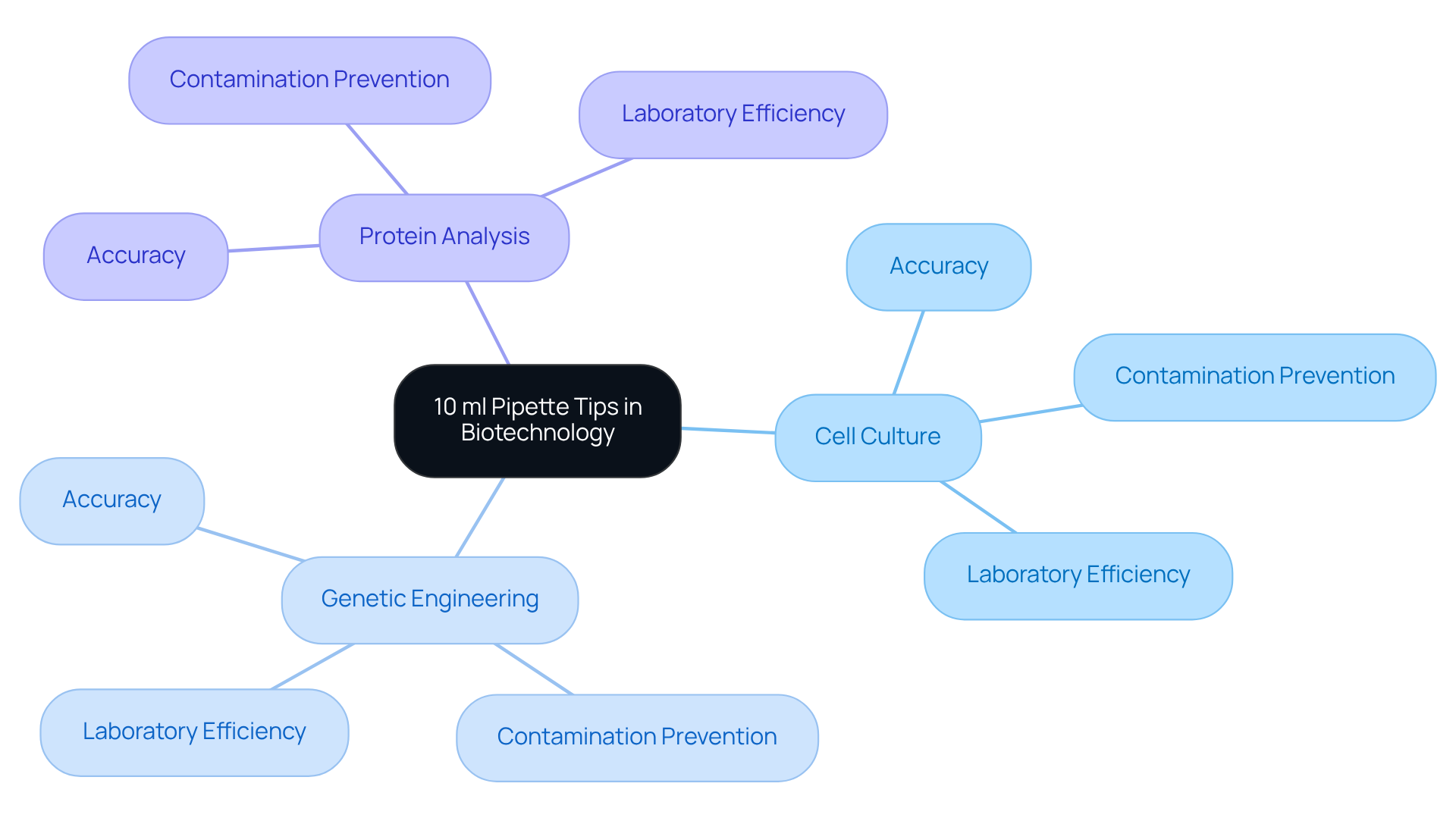
Food and Beverage Testing: Ensuring Quality with 10 ml Pipette Tips
In the food and beverage sector, 10 ml pipette tips are indispensable at dispensing points for quality testing and analysis. These instruments facilitate precise measurements of ingredients, additives, and contaminants, which are essential for ensuring compliance with safety and quality standards.
The precision provided by these laboratory tools is critical for conducting tests such as microbial analysis, chemical composition assessments, and nutritional content evaluations. High-quality laboratory tools significantly enhance testing processes, resulting in more reliable outcomes and improved product safety.
Authorities in food safety emphasize that the accuracy of dispensing instruments, including the 10 ml pipette tip, directly affects the precision of microbial analysis, which is crucial for detecting harmful pathogens. As one specialist noted, "The dependability of our testing results depends on the quality of the instruments we utilize, including transfer device ends." These instruments are fundamental in achieving accurate measurements that protect public health.
With the projected to reach USD 38.25 billion by 2030, the demand for precise testing is more critical than ever. The CDC estimates that 1 in 6 Americans experience food poisoning annually, underscoring the urgent need for high-quality laboratory tools in testing protocols. By investing in superior transfer tools, food testing facilities can ensure that their examination protocols yield reliable outcomes, ultimately enhancing the safety and quality of food products.
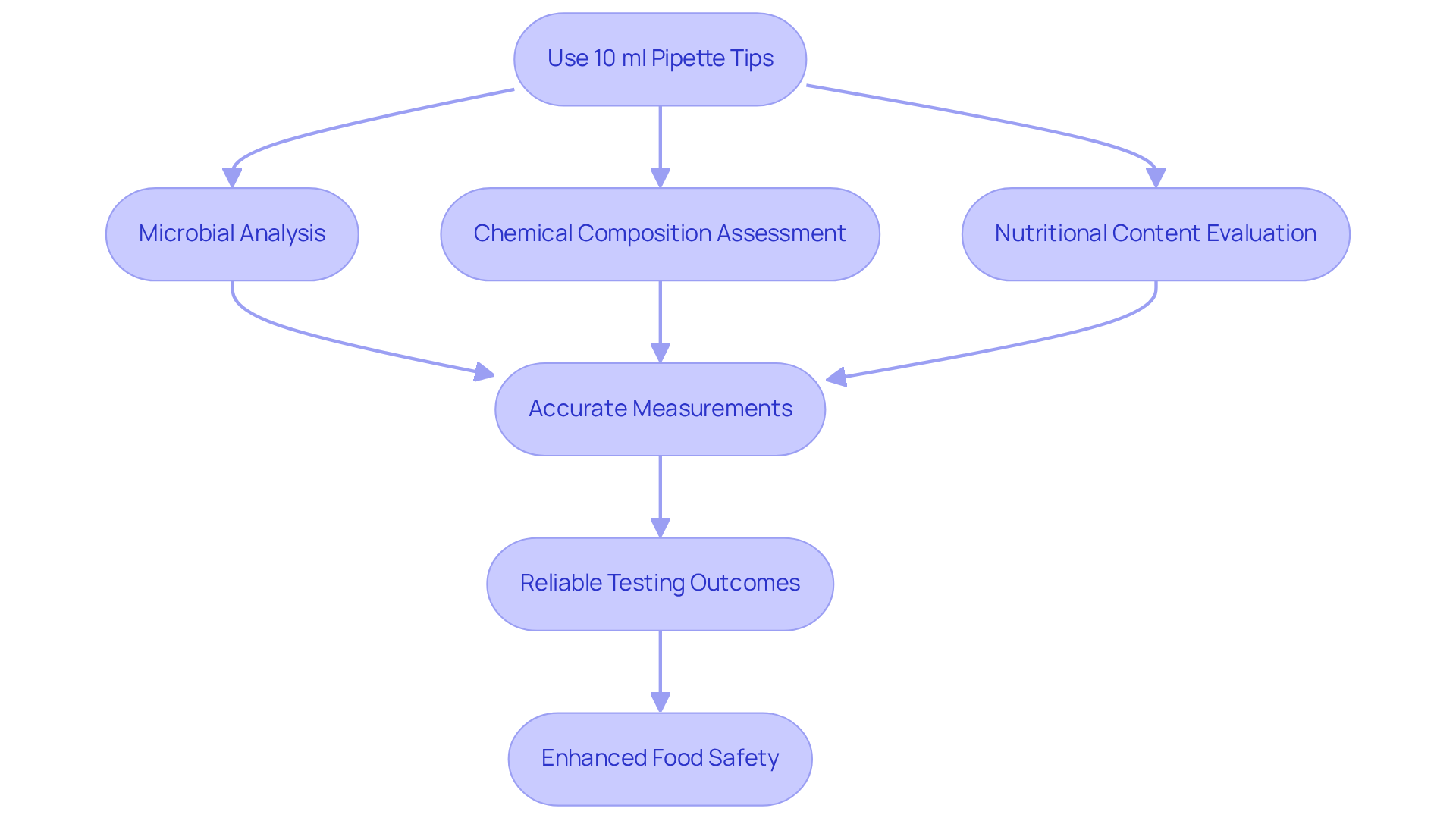
Versatility in Laboratories: The Essential Role of 10 ml Pipette Tips
The 10 ml pipette tip is a vital dispensing tool utilized across various sectors, including pharmaceuticals, research, education, and environmental testing. Their design ensures compatibility with multiple pipette brands, providing facilities with the necessary flexibility to optimize their workflows.
These tools excel in handling larger quantities, making them ideal for tasks such as sample preparation, reagent transfer, and quality control testing. This adaptability not only boosts efficiency in research environments but also supports a diverse array of scientific applications.
With the pipette accessories market projected to grow from $2.28 billion in 2024 to $2.46 billion in 2025, the like the 10 ml pipette tip underscores their essential role in modern research practices. By integrating these tools into their operations, laboratories can enhance productivity and ensure precise liquid handling, ultimately contributing to the reliability of their research outcomes.
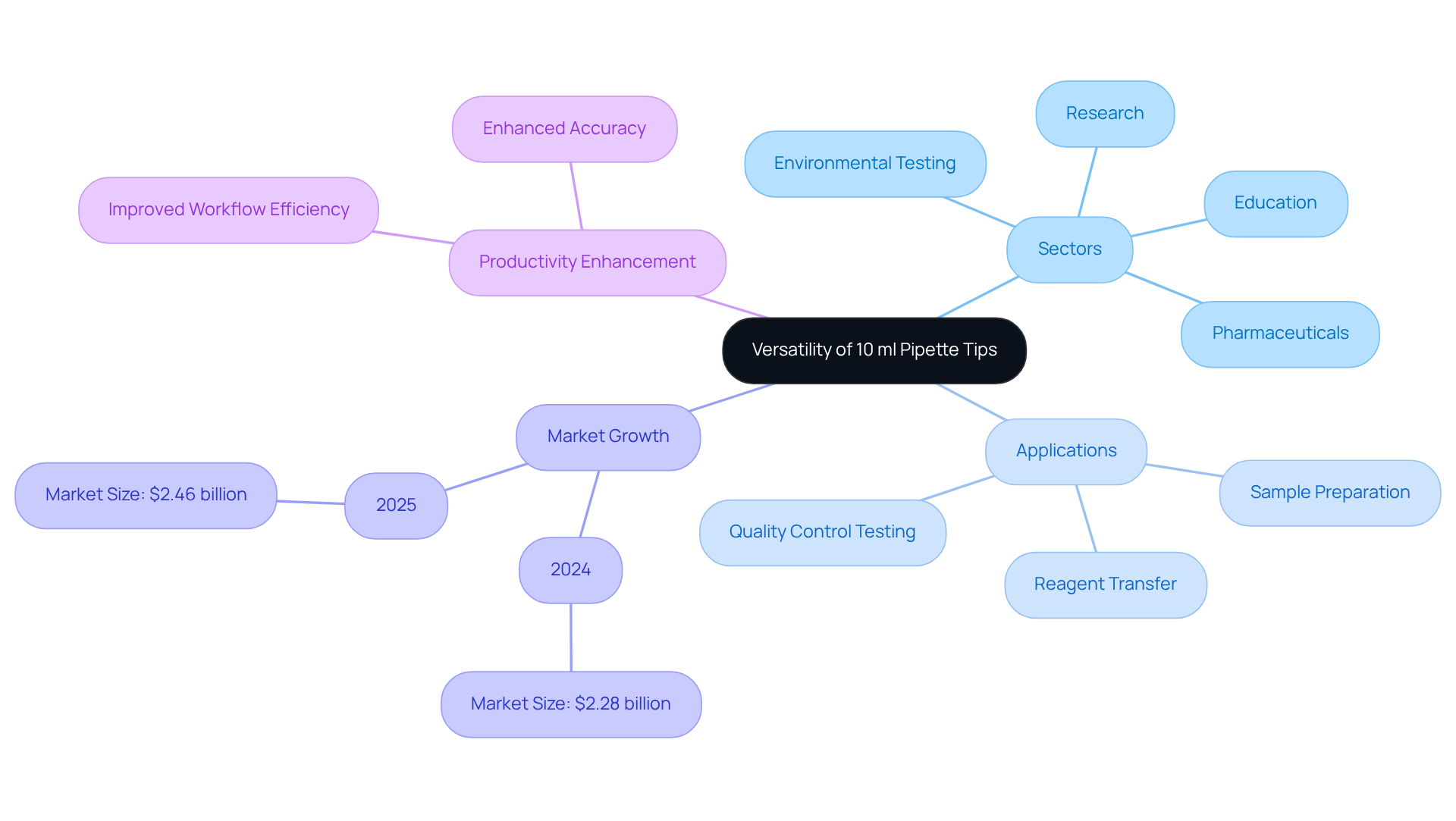
Conclusion
The significance of 10 ml pipette tips in pharmaceutical labs is paramount, as they ensure precision and accuracy in liquid handling. These tools are essential across various applications, from drug development to quality control, where even the slightest inaccuracy can lead to substantial repercussions. By facilitating reliable sample transfers and minimizing contamination risks, 10 ml pipette tips enhance the integrity of experimental outcomes, thus contributing to the overall success of pharmaceutical research.
This article has explored key insights into the applications of 10 ml pipette tips, revealing their versatility across multiple sectors, including medical diagnostics, environmental testing, education, and biotechnology. Each application underscores the importance of precision in achieving reliable results, whether it involves formulating drugs, conducting quality assessments, or teaching essential laboratory techniques. The anticipated growth in the liquid handling market further highlights the increasing demand for these indispensable tools in modern laboratories.
Ultimately, investing in high-quality 10 ml pipette tips transcends mere laboratory efficiency; it ensures the accuracy and reliability of scientific endeavors that can impact patient safety and public health. As laboratories evolve and adapt to new challenges, the commitment to precision in liquid handling remains a cornerstone of successful research and development. Embracing these tools and prioritizing their use will pave the way for innovative breakthroughs in the pharmaceutical and biotechnology industries, reinforcing their vital role in advancing science.




